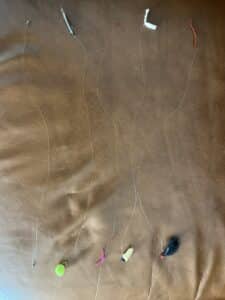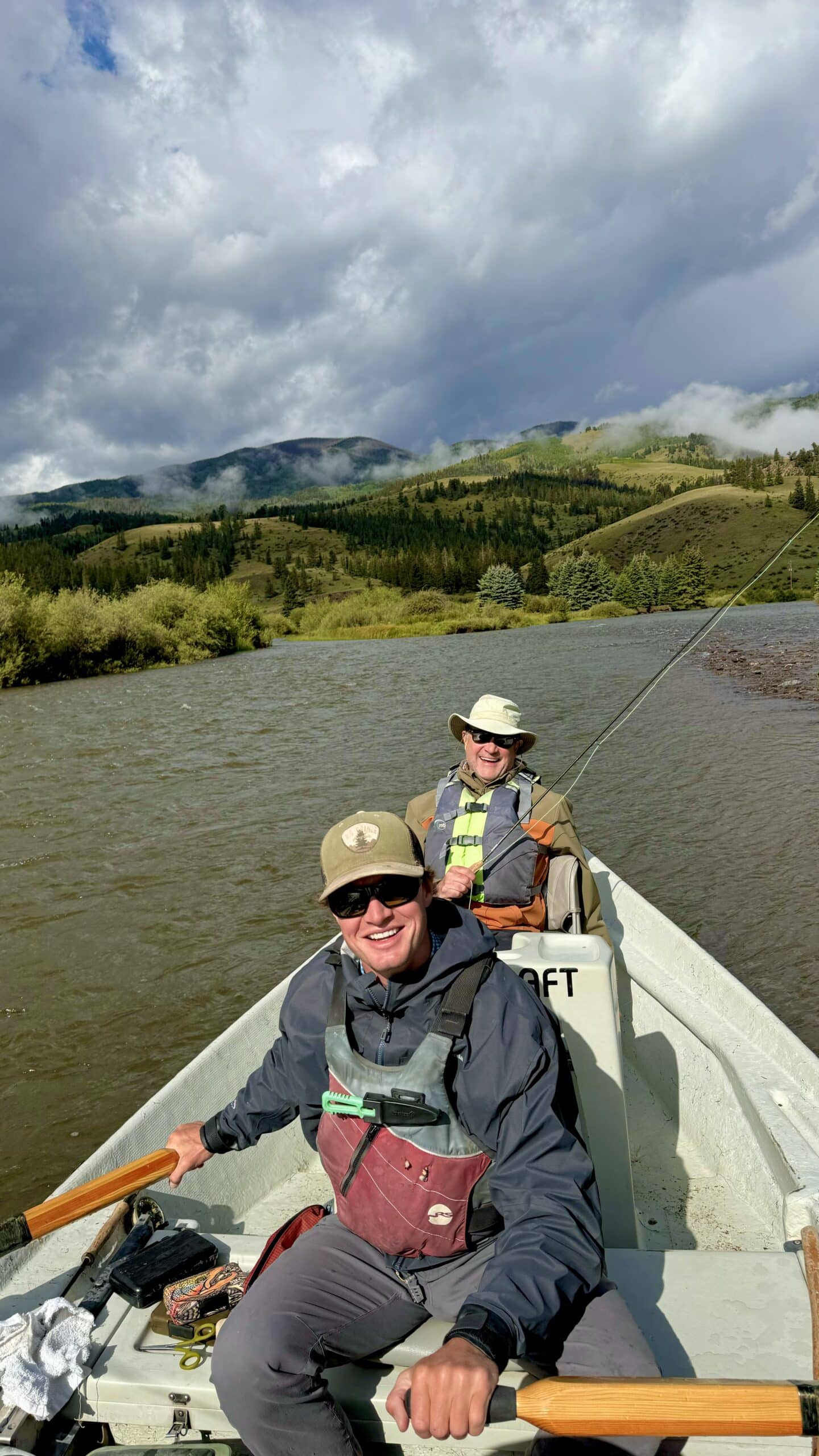The San Juan River in Navajo State Park, also known as the Quality Water section, is a great place to fish year round and is a great option for fishing in the winter. The water is typically a milky green color and people have anywhere from 6 inches to two feet of visibility. This blog will cover tactics and fly selection for fishing during the winter on the quality water section of the San Juan.
Everything written in this blog and every other blog, is my opinion based on personal experience. I hope everyone can gain some insight or confirm their own thought processes when reading my blogs. Enjoy!
Common Flies
Annelids
The San Juan is loaded with midge larvae in various sizes. Some favorite patterns to imitate these larvae during the winter months are annelids. Annelids in sizes 14-18 are my favorites for the winter months. Because the water is off color, it pays to have a fly that stands out. There are many different colors to throw and red, orange, cream with brown ribbing, and maroon are great options.
Eggs
Love them or hate them, eggs can be very productive during this time of year. The browns are spawning from October to as late as late December and early January and fish are keyed into the influx of eggs in the water. The San Juan also has many rainbows that will be off their ticker and dumping eggs year round. Fish are used to seeing eggs in the river and this is a great source of protein for them.
On sunny days, chartreuse green and bright orange can be great options. On cloudy days, cranberry and dark yellow seem to be more productive. Don’t be afraid to go big. There have been some great days of fishing with glo bugs as big as your thumb nail as your attractor fly.
Oftentimes, throwing an egg on your rig is a good idea simply to bring attention to the other fly. Whether that’s an annelid, buckskin worm, san juan worm, midge, etc… There have been days where putting an egg pattern on changes how often that bobber is shooting down.
Fishing eggs isn’t for everybody, but if you’re ever having a slow day during the winter months the egg can be worth exploring.

Different san juan worms and mop flies
Worms
The San Juan Worm did not earn the name it has for nothing. This is a go to fly during the winter months. Try experimenting with different sizes however. Some days they will eat a worm that’s an inch to two inches long and other days they want a pattern that’s a quarter to an eighth of an inch long.
Popular colors are neon pink, burnt orange, wine, or cream. I like fishing these patterns close to the bottom of the river so don’t slack on your depth or weight. Don’t overlook this pattern. It’s been around a long time for a reason!
The buckskin worm can really hunt during the winter months. Many aquatic worms are actually flat on one side so the buckskin worm imitates this nicely. Similar to the san juan worm, play with the size you’re throwing. I like throwing lighter brown colors and also will hug the bottom of the river when throwing these.
Larger buckskin worms can imitate leeches as well which is a great option on the San Juan
Mop Flies
The fish on the San Juan will gorge themselves on floating moss and lake sludge. This floating debris will carry many midges and aquatic worms and it’s a good bang for their buck when they eat moss. As anglers, we can imitate this by using different color mop flies.
Chartreuse, cream, and light pink are some favorite colors down there. This also makes a great attractor fly if they aren’t out right eating it. There are also many crane fly larvae in the san juan so a cream mop fly fits the bill nicely. I like the larger sizes of the mop fly so anywhere from a 12-16.
Baetis Patterns
As the winter months progress we start to see larger size baetis coming off. Typically mid winter, the baetis are not hatching enough for the fish to totally key into them. As we approach late Feb. and March we will start to see larger quantities of these bugs appear.
Light olive and brown seem to be the ticket with these bug imitations. I like to fish in the upper water column when throwing baetis patterns. I will throw very light weights and shorter rigs to stay in the preferred water column. The “twitch” can be very effective. Depending on what speed water is being fished, try to put small twitches or long slow drags on your rig. Oftentimes, this will elicit a sharp, fast paced bobber down.
Leeches
A personal favorite of mine for winter fishing the San Juan is a leech pattern. There is such a variety of ways to fish them and no shortage of different colors and patterns. As mentioned earlier, fish in this section of river eat a lot of moss and sludge. The leech can be a perfect imitation of this.
I like pine squirrel leeches, mayer’s leech, buggers, etc.. There are so many options to choose from. I love a dark green in larger size leeches and black, gray, brown and white in medium to small sizes.
Adding a hot spot head to this pattern is the difference between a great day and a slow day sometimes so hit the water with some options. I like pink and bright orange for the heads. These are patterns you can twitch, swing, dredge. All depends on what you’re trying to imitate.
Although it may seem like too much, I have dead drifted size 8 bunny leeches and had some fantastic days on the San Juan. Don’t be scared to go big if you are not having the day you thought you should be.
Winter Fishing The San Juan Rig Combos

Example of some common rigs
This does not always hold true but the higher upriver I am on the San Juan, the more “junk” i’m going to throw. And remember, I am referring to winter fishing so December- Mid February. Texas hole-Cable I throw a lot of leeches and worms, leech to buckskin, mop fly to worm/bucksin, egg to leech, egg to worm, etc…
When I am fishing with these styles of bugs I typically will separate my flies anywhere from a foot to two feet.
If I am not on fish within the first few drifts I will change my depth (typically deeper) and then I’ll change weight. If this isn’t getting it done I will change my bugs. If I am throwing a green leech to a pink worm and not catching, I would switch to a black leech to a cream mop or black leech to an egg. Make a big color change. Again, I am assuming there are not many bugs coming off and the fish are not rising or swirling the surface for insects. We are talking about junk fishing T-hole and up.
As we move down river to Three Island, lunker alley, and Munoz I will typically change from throwing any eggs (not saying eggs can’t be good here) and move into larger leeches and larvae patterns. If there are bugs coming off I will start to throw some pupa imitations. The past month (January) there has not been much of a hatch going on.
Get Outside
It’s hard to have a bad time when you’re fishing. Winter fishing the San Juan is a great option to get outside and put the waders on or jump in a boat. I hope this post is able to help some of you find your way on the Juan during the winter time.
Don’t let the murky water push you away. The fish are still eating and it’s a great time of year to avoid the crowds. If you’re not hooking into fish, switch depth, then flies, and then try a new presentation. Something is always feeding on the Juan so you should get into some fish.
Always feel free to reach out for information on river updates or to talk about a guide trip. I would be happy to show anyone how I fish the San Juan during the winter months! Hopefully I will see you on the river, cheers!

Caiden is a life-long fishing enthusiast and is the owner and head guide at Cut Bank Outfitters.

